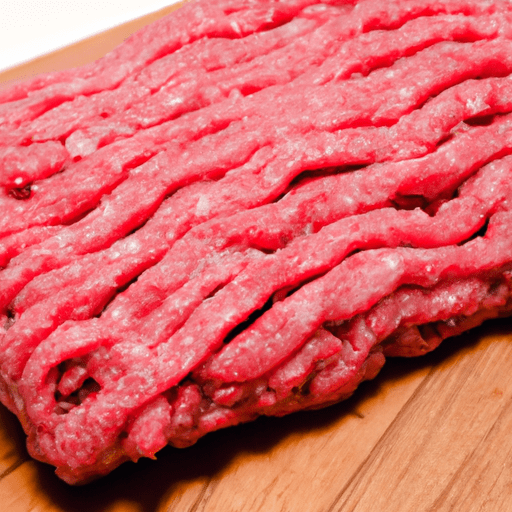Exploring the Culinary Wonders of Extra Lean Ground Beef
When it comes to versatile ingredients that anchor countless beloved recipes, few can compare to the enticing qualities of extra lean ground beef. This culinary powerhouse is not only a staple in many households but also a popular choice for chefs worldwide. Delve into the world of extra lean ground beef as we uncover its exceptional taste, explore its common uses in cooking, shed light on its nutritional value, and unearth some fascinating facts about this kitchen superstar.
A Delicious Journey for the Taste Buds
Extra lean ground beef is a delightful combination of beef cuts with a reduced fat content, making it a flavorful yet healthier option. Its robust taste is rich, meaty, and distinctly savory, making it an ideal choice for a wide range of dishes. Whether it’s the star ingredient of a juicy burger, the foundation of a hearty Bolognese sauce, or the filling of a comforting meatball, the taste of extra lean ground beef adds depth and satisfaction to every bite.
Versatility at Its Finest
Extra lean ground beef boasts a remarkable versatility that makes it a crucial component in countless recipes from diverse cuisines. This culinary superstar finds its way into homey classics like meatloaf, chili, and tacos, as well as more refined dishes such as lasagna and stuffed peppers. Its ability to absorb and enhance flavors makes it an excellent choice for experimenting with different herbs, spices, and seasonings. From Italian-style meatballs to Mexican-style empanadas, the possibilities are truly endless when it comes to unleashing the potential of extra lean ground beef in the kitchen.
Nutritional Powerhouse
Beyond its delectable taste and adaptability, extra lean ground beef also packs a nutritional punch. This lean protein source is a rich provider of essential nutrients, including iron, zinc, and vitamin B12. Additionally, it is a great source of high-quality protein, crucial for building and repairing tissues in the body. With its reduced fat content, extra lean ground beef offers a healthier alternative to its higher-fat counterparts, making it an excellent choice for those seeking a balanced diet without compromising indulgence.
Discovering Fun Facts about Extra Lean Ground Beef
Here are some intriguing facts that will further pique your interest in extra lean ground beef:
Evolution of Tasty: Ground beef has a long history and has been enjoyed in various forms for centuries. Its modern incarnation can be traced back to German immigrants who brought the technique of grinding beef to America in the 19th century, leading to the creation of iconic dishes like hamburgers.
Lean and Mean: The term “extra lean” signifies that the beef contains less than 10% fat content, making it a lean and healthy option for cooking.
Variety of Cuts: Extra lean ground beef can be made from a variety of beef cuts, including round steak, sirloin, or even a combination. The choice of cuts can impact both the flavor and texture of the beef, offering endless possibilities for culinary experiments.
The Perfect Ratio: When creating the perfect blend of fat to lean meat, the ideal ratio for extra lean ground beef is often considered to be 90% lean and 10% fat. This balance ensures that the beef retains its juiciness and flavor while still maintaining a reduced fat content.
Handling with Care: Due to its lower fat content, extra lean ground beef can be slightly less forgiving than fattier blends. It is important to handle it with care during cooking to prevent it from drying out. Incorporating moisture-rich ingredients or using gentle cooking methods can help maintain its tenderness and succulence.
In Conclusion
Extra lean ground beef is undoubtedly a culinary gem with endless possibilities. Its robust taste, versatility in various recipes, and impressive nutritional value make it a beloved ingredient in kitchens around the globe. From comforting classics to bold and innovative creations, this lean protein source offers a delectable canvas to unleash your culinary creativity. So, next time you’re meal planning, consider embracing the distinct flavors and possibilities of extra lean ground beef – your taste buds and your body will thank you!
Origin:extra lean ground beef is derived from cattle, which have been domesticated for thousands of years. The practice of grinding meat has been used for centuries to make it more tender and allow for easier cooking.
Common uses:Extra lean ground beef is a versatile ingredient, commonly used in a variety of dishes. It is frequently used in recipes for hamburgers, meatballs, meatloaf, and various other ground meat preparations. It can also be used in soups, sauces, chili, and casseroles, among other dishes.
Nutritional benefits: Extra lean ground beef is a good source of high-quality protein, providing all the essential amino acids required for the body’s growth and repair. It is also rich in various vitamins and minerals, including B vitamins (such as B12 and niacin), zinc, phosphorus, and selenium. However, the specific nutritional composition can vary depending on factors such as the animal’s diet and the cut of meat used.
Unique properties: Extra lean ground beef is typically made from lean cuts of beef, such as sirloin or round. The term “extra lean” indicates that it contains less than 5% fat per 100 grams. This makes it a healthier option compared to ground beef with higher fat content. The low fat content can result in a drier texture, requiring additional ingredients or cooking techniques to maintain moisture.
Historical significance: Ground beef has played a significant role in the history of food processing and preservation. The grinding of meat allowed for the creation of sausages, meatballs, and other types of ground meat products that could be preserved for longer periods. Ground beef also gained popularity with the rise of fast food restaurants in the 20th century, where it became a staple ingredient for hamburgers and other quick-service meals.




Use the share button below if you liked it.
It makes me smile, when I see it.